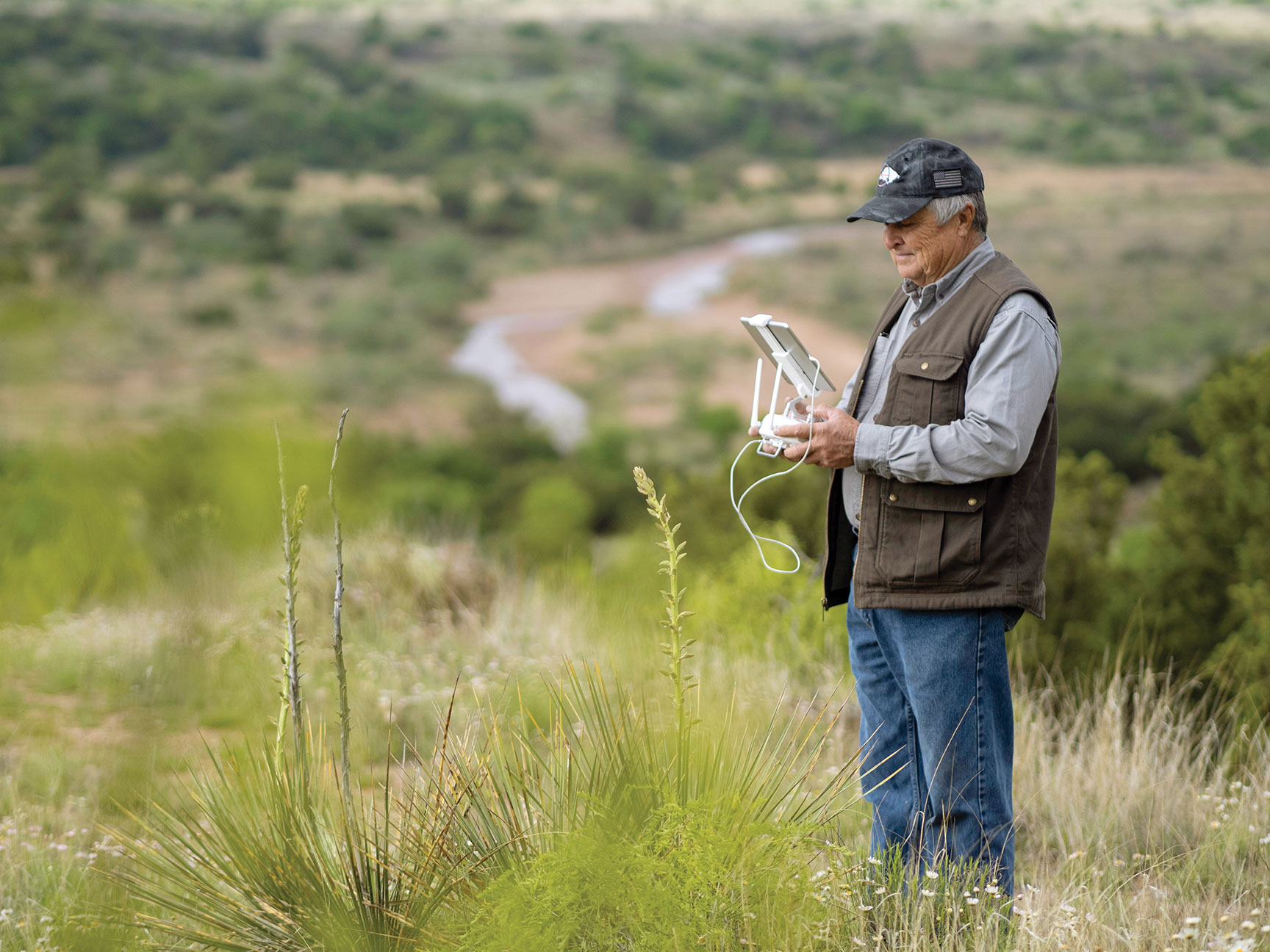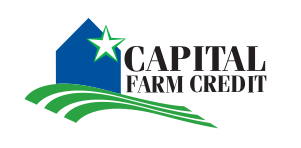Connected Cattlemen

Beef cattle operations are investing in technology and saving time and money.
These days, technology is everywhere.
It's down four miles of caliche road. It's in the center of a stocker-filled wheat field. And it's in the pocket of most ranchers, whether they want it or not.
For all the benefits of unplugging from time to time, there are just as many for plugging in at the ranch. Three Capital Farm Credit borrowers say going high-tech has helped their operations do more with less.
Up in the Air
Ranching can be tough in the rough terrain just north of Matador, Texas.
Especially when the rain falls.
Coy Franks, a longtime Capital Farm Credit customer who runs a commercial cow-calf operation, found a solution. The pilot and model airplane hobbyist bought a drone. As the quadcopter flies high above the often-washed-out ranch roads and treacherous quicksand, it serves as Franks' eyes and ears in places he can't reach by truck, horse or ATV.
But he uses it in fair weather, too.
"I got lazy," the cattleman says with a laugh. "A drone can do a lot of the jobs I used to."
Franks has water gaps on two rivers, about a dozen altogether. Before, it would take him two or three days to check them all. Now he can get to them in half a day, because he doesn't have to drive.
Searching for Missing Cattle
Franks also uses the drone to look for missing cattle.
"One day I got a call from a friend. He's got a pasture that's really brushy, and it was especially bad at the time. He couldn't find some cows, so my grandson and I went in," Franks says. "We found the cows and herded them right out of that pasture with the drone."
While his piloting and model airplane experience made the transition to a drone easy, he says ranchers without similar experience shouldn't feel intimidated.
"Model airplanes are hard to fly. They're not forgiving at all," Coy says. "Drones are a piece of cake."
He believes anyone — with a little practice, of course — can fly a drone.
"The situational awareness is the biggest obstacle," he says. "If you're not a pilot, you won't automatically understand that when you get up and look down on something, it's different than looking at it on the horizontal plane. But you learn that real quick."
Choosing the Right Model
Unlike his 15-year-old grandson, Franks says he's not up on the latest drone technology. He does, however, have one recommendation for any rancher considering one: Look for models with a "return home" feature.
"If you get it lost, you press that button and just sit there and wait," he says. "It comes back to you by itself."
See video of Coy Franks' drone in action at www.FindFarmCredit.com/CoyFranks
Seedstock Solutions
Every cow has a story.
At Halfmann Red Angus near Miles, Texas, it's dangling from her ear.
The seedstock operation, which has a long relationship with Capital Farm Credit, uses electronic identification, or EID, tags on each of its animals. The tags work in conjunction with a Gallagher TSI scale head/data collection tool and a Bluetooth reader.
Cody Halfmann says there is no doubt the technology helps him, his brother, Chad, and his dad, Glen, use their time more efficiently and do a better job managing their cattle.
Storing Herd Records
"If we're chute-side and a cow comes up, with a quick scan I can pull up her pedigree, her progeny, her vaccination record — everything that's ever happened to her," he says.
At times — like when artificially inseminating the cows — it's necessary to treat each animal as an individual. But there are other times when the majority of the herd gets the same treatment. At those times, the Halfmanns' system is a big time-saver.
"We've got one place we can load 20 or 30 cows up in a big snake," Cody says. "And if we're doing the same thing to each of them, I can set a default as the four or five processes we are doing. And then all we have to do is scan the animal, and it adds the rest."
Prescribing the Right Formula
Chad's favorite aspect of the system is that it will allow him to customize data and create his own formulas.
"For example, say we're giving LongRange dewormer. The product is based on weight. And it's expensive, so you don't want to overdose, but you also don't want to underdose," Chad says.
"We've programmed a formula in where, as soon as the animal's weight comes up, it will tell us exactly how many milliliters it needs," he adds.
The thirtysomething brothers have been back on the ranch for several years since working in accounting and information technology, respectively. Given their backgrounds, you might think they're the reason for the family's high-tech approach to ranching. But Cody is quick to pass the credit to their dad, Glen.
"My father has always been very open to innovation and new ideas," Cody says. "He has been really innovative. When we were kids, he was bringing new technology to the ranch and to our farm. And now, he's almost given us free rein, in a way, to go out there and look for new things to bring in so we can do better."
There Wasn't an App for That
Alan Schaffner doesn't consider himself a high-tech guy.
He does, however, consider himself a guy who likes efficiency. And there came a time when pen-and-paper record-keeping wasn't cutting it for him anymore.
He couldn't get caught up, he couldn't track what he wanted, and the shoeboxes full of receipts were getting out of control.
The rancher, who runs about 300 head of commercial Angus cows in Clay County, Texas, tried a couple of cattle business apps. But he found they were either intimidating or didn't fit his needs as a commercial cow-calf producer.
That's when Schaffner, who has been a Capital Farm Credit customer since the mid-1980s, decided to create his own.
"I came in one day and asked my wife, 'What would you think if I were to develop a livestock app?'" he says. "And she looked at me like I was crazy, and — this is the gospel truth — said, 'What do you know about apps?'"
Appealing to Low-Tech Ranchers
What he did know was what he wanted in one: the ability to track as little or as much information as he wished, either at the pasture or individual cow level. At the same time, it needed to be easy for a low-tech rancher to learn.
Over the past couple of years, Schaffner has worked with developers to perfect the app and get it ready for release this summer. In the meantime, he's been using it himself and couldn't be happier with the information available in his pocket.
The app allows him to record vaccination records, feed and hay purchases, and stocking rates, as well as other data. He also can add auction settlement sheets to easily track how his steers sell. And, of course, that data syncs across his devices.
No signal? No problem. Information is stored to your phone until you have more bars.
"I could put this on a piece of paper and put it in the truck," Schaffner says. "But then you go back and look at it, and (wonder) was it done in November or January? And what if my notepad blows out of the truck or gets rained on or left at home? I'll tell you what, my phone stays pretty close to me."
And so do his records.
